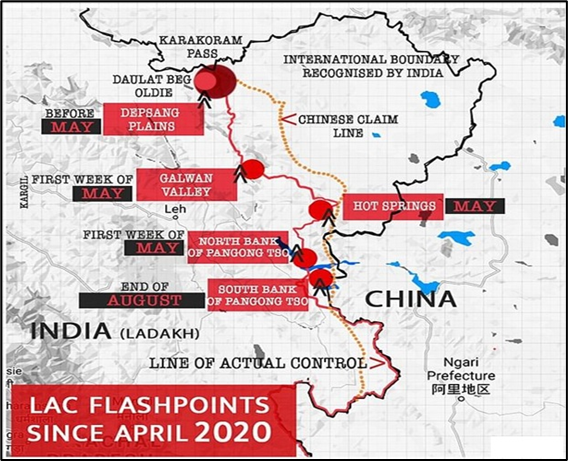Why in News?
Speaking at a think tank in New York, foreign minister S Jaishankar described India-China ties as "significantly disturbed".
This comes after his recent statement claiming that the two neighbours have resolved 75% of "disengagement problems" along the Line of Actual Control (LAC) in eastern Ladakh.
What’s in Today’s Article?
- Evolution of the India - China Relations
- How India Responded to an Assertive China?
- Current State of India - China Relations
- Efforts to Break the Deadlock in the India - China Relations and Way Ahead
Evolution of the India - China Relations:
- During the course of the 1990s and until 2013:
- Sharing the goal of avoiding another border war akin to that of 1962, India and China agreed to set aside their differences on the border and focus on their economic development.
- Each involved the other on secondary issues such as terrorism or Afghanistan.
- National interests began to diverge after 2013:
- Coinciding with lower economic growth prospects, President Xi Jinping pursued an assertive foreign-policy and security agenda by -
- Focusing on promoting global technology champions and its Belt and Road Initiative (BRI),
- Acquiring advanced dual-use technologies and securitising its economy at home.
- This created insecurity for India.
How India Responded to an Assertive China?
- India has concurrently considered itself a rising global economic force able to leverage its strategic partnerships in Asia and beyond.
- Since the end of the coronavirus pandemic, India has gained confidence from its status as the world’s fastest growing major economy.
- India’s ambitions evolved from seeking to be the ‘plus-one’ of multinationals’ China-focused strategies to being a preferred, trusted middle-weight supplier in global supply chains.
- India’s ‘Make in India’ policy epitomises its ambitions to grow its services and industry, using foreign capital to eventually boost exports.
Current State of India - China Relations:
- India - China ties are troubled by -
- An unsettled border, an unequal trade relationship, China’s strategic ties to Pakistan, and
- A broadening political-strategic disagreement over each other’s perceived rightful place in Asia and beyond.
- The relationship has suffered from a lack of strategic trust since a June 2020 border clash (in the Galwan valley).
- This unmined the letter and spirit of the border-management regime that had been patiently negotiated, designed and agreed to over a generation.
- The war in Ukraine has brought China closer to Russia, India’s historic defence partner.
- The decline in relations is evident by the Chinese President declining to attend the 2023 G-20 summit in New Delhi and the Indian PM’s lack of attendance at the 2024 SCO summit in Kazakhstan.
Efforts to Break the Deadlock in the India - China Relations and Way Ahead:
- Resolution of disengagement problems through strategic communication:

- After a hiatus of over two years, their top national-security officials met in 2022, 2023 and July 2024.
- As a result, the two neighbours have resolved 75% of "disengagement problems" in eastern Ladakh.
- Friction points such as Galwan Valley, north and south banks of Pangong Tso and the Gogra-Hot Springs area have been resolved to some extent with the creation of buffer zones along the LAC.
- However, legacy issues of Depsang Plains and Demchok (pre-dating the current ongoing military standoff) remains.
- As a result, troops deployed at the Depsang Plains were blocked from accessing their patrol points in an area called the Y junction.
- Deployment of troops through intensified diplomatic and military talks:
- The delegation for the 31st Working Mechanism for Consultation & Coordination on India-China Border Affairs (WMCC) discussed the issue of deployment of troops along the LAC in eastern Ladakh.
- The 22nd round of military talks between India and China at the Corps Commanders’ level may set the time frame of the deployment of troops from either side based on the mutual agreement reached.
- This might help the Indian troops regain access to some of the patrolling points along the LAC.
- Irrespective of any deployment change, the border infrastructure development along the entire LAC will continue as per plans.
- Way Ahead:
- As the India - China relationship is key to Asia's future and will influence not just the continent but the entire world, there is the avoid any further tensions which could distract them from their peaceful rise.
- One possible route is to establish new confidence-building measures.










